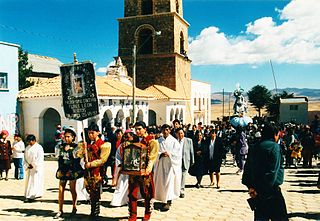Related Research Articles

La Paz, officially Nuestra Señora de La Paz, is the seat of government of the Plurinational State of Bolivia. With 755,732 residents as of 2024, La Paz is the third-most populous city in Bolivia. Its metropolitan area, which is formed by La Paz, El Alto, Achocalla, Viacha, and Mecapaca makes up the second most populous urban area in Bolivia, with a population of 2.2 million, after Santa Cruz de la Sierra with a population of 2.3 million. It is also the capital of the La Paz Department.

Puno is a department and region in southeastern Peru. It is the fifth largest department in Peru, after Cuzco, Madre de Dios, Ucayali, and Loreto. It is bordered by Bolivia on the east, the departments of Madre de Dios on the north, Cusco and Arequipa on the west, Moquegua on the southwest, and Tacna on the south. Its capital is the city of Puno, which is located on Lake Titicaca in the geographical region known as the Altiplano or high sierra.

Lucanas is the largest province in the Ayacucho Region in Peru. Its seat is Puquio.

The Yauyos Province is a province located in the Lima Region of Peru. It is one of the eleven that make up that region.
Circa is one of the nine districts of the Abancay Province in the Apurímac Region in Peru.

Pichacani or Pichaqani is one of fifteen districts of the Puno Province in the Puno Region in Peru.

Moho District is one of four districts of the province Moho in Peru.

Desaguadero or Chaka Marka is a town on the Bolivian-Peruvian border. On the Bolivian side it is situated in the La Paz Department, Ingavi Province, Desaguadero Municipality, Desaguadero Canton. On the Peruvian side it lies in the Puno Region, Chucuito Province, Desaguadero District. Both parts of the town are united by a binational bridge.

Calamarca or Qala Marka is a town in the La Paz Department in Bolivia. It is the seat of Calamarca Municipality, the fourth municipal section of Aroma Province. It lies on the Altiplano on the east side of the main road between La Paz and Patacamaya, about 60 km south of La Paz.
Kenko,Qenqo or Q'inq'u or also Inka Anatawi is an archaeological site in Peru. It is located in the Puno Region, Puno Province, Acora District, at an elevation of about 4,000 m (13,000 ft). The site was declared a National Cultural Heritage (Patrimonio Cultural) of Peru by the National Institute of Culture.
Intini Uyu Pata or Inti Uyu is an archaeological site in Peru. It is located in the Puno Region, Yunguyo Province, between the districts Ollaraya and Unicachi, at a height of about 3,867 m (12,687 ft). The site was declared a National Cultural Heritage (Patrimonio Cultural) of Peru by the National Institute of Culture.

Qulu Qulu is an archaeological site in Peru. It is located in the Puno Region, Sandia Province, Patambuco District. The site was declared a National Cultural Heritage (Patrimonio Cultural) of Peru by the National Institute of Culture.
Molloko is an archaeological site in Peru. It is located in the Puno Region, Puno Province, Acora District, about 5 km south of the town of Acora, near the village of Molloco. The site was declared a National Cultural Heritage (Patrimonio Cultural) by the National Institute of Culture.
Pumamarka is an archaeological site in Peru. It is located in the Cusco Region, Urubamba Province, Ollantaytambo District, at the confluence of the rivers Patakancha and its affluent Yuraqmayu.
Pumamarka (Aymara and Quechua puma cougar, puma, marka village, "puma village", is an archaeological park in Peru. It is located in the Cusco Region, Cusco Province, San Sebastián District, on the left side of the river Pumamarka. The site was declared a National Cultural Heritage of Peru by the National Institute of Culture.
Tanqa Tanqa or Tanka Tanka is an archaeological site in Peru. It is located in the Puno Region, Chucuito Province, Zepita District. The site was declared a National Cultural Heritage (Patrimonio Cultural) of Peru.

Asiru Phat'jata is a hill in Peru, situated at a height of about 3,895 metres (12,779 ft). It is located in the Puno Region, Yunguyo Province, Yunguyo District. Asiru Phat'jata lies near Lake Titicaca at the road which connects Yunguyo and Puno, south of the village Asiru Phat'jata (Acero Patjata) and north of the mountain Qhapiya.
Pirca Pirca is an archaeological site in Peru. It is located in the Lima Region, Yauyos Province, Tanta District. Pirca Pirca was declared a National Cultural Heritage of Peru by Resolución Viceministerial No. 011-2013-VMPCIC-MC on February 7, 2013. It lies north of Lake Paucarcocha.
Taruja Marka or Taruka Marka is a mountain in the La Raya mountain range in the Andes of Peru, about 5,000 metres (16,404 ft) high. It is situated in the Puno Region, Melgar Province, on the border of the districts of Nuñoa and Santa Rosa. Taruja Marka lies near the La Raya pass, northwest of the mountain Yanaqucha and northeast of Chimpulla.
Mullu Q'awa is an archaeological site in Peru on a mountain of that name. It is located in the Cusco Region, Espinar Province, Alto Pichigua District. It lies near the village of Mullu Q'awa (Molloccahua, Molloqhawa). It is situated on top of the mountain at a height of about 4,000 m (13,000 ft).
References
- ↑ Ludovico Bertonio, Aymara-Spanish dictionary (transcription)
- 1 2 mincetur.gob.pe Archived 2014-02-04 at the Wayback Machine "Sitio arqueológico Merquemarka", retrieved on January 25, 2014